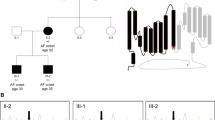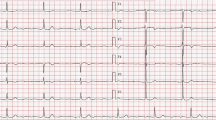Abstract
Background and Objective: Lamin A/C (LMNA) gene mutations cause dilated cardiomyopathy, often accompanied by conduction disturbances. Our aim was to search for LMNA mutations in individuals with atrial fibrillation.
Methods: A cohort of Polish subjects (N = 103) with non-valvular atrial fibrillation with a high (48.5%) prevalence of conduction system disturbances was screened for LMNA variants by direct DNA sequencing.
Results: We found a single non-synonymous variant (Thr528Met) in a 72-year-old patient with normal left ventricular function and episodes of advanced atrioventricular block. One of his two mutation-carrying daughters had episodes of type I second-degree atrioventricular block on a 24-hour Holter ECG and peak exercise arrhythmia. Interpretation of cardiac anomalies observed in the other daughter was complicated by thyroid insufficiency. A Thr528Met weak pathogenic effect was supported by transient transfections of C2C12 mouse myoblasts and computationally. Another interesting variant was Ile26Ile (c.78C>T), found in a New York Heart Association class III patient with a depressed left ventricular ejection fraction (30%), left bundle branch block, and a family history of heart disease. Ile26Ile was absent in 246 healthy individuals and was computationally predicted to interfere with splicing.
Conclusion: LMNA mutations are not a frequent cause of atrial fibrillation even when conduction disease is present. Unlike the majority of LMNA mutations clearly associated with a severe clinical phenotype and a poor prognosis, Thr528Met results in a more subtle pathogenic effect, while Ile26Ile should be considered as a variant of unknown significance.






Similar content being viewed by others
References
Worman HJ, Fong LG, Muchir A, et al. Laminopathies and the long strange trip from basic cell biology to therapy. J Clin Invest 2009 Jul; 119(7): 1825–36
Sylvius N, Bilinska ZT, Veinot JP, et al. In vivo and in vitro examination of the functional significances of novel lamin gene mutations in heart failure patients. J Med Genet 2005 Aug; 42(8): 639–47
Hermida-Prieto M, Monserrat L, Castro-Beiras A, et al. Familial dilated cardiomyopathy and isolated left ventricular noncompaction associated with lamin A/C gene mutations. Am J Cardiol 2004 Jul 1; 94(1): 50–4
Vytopil M, Benedetti S, Ricci E, et al. Mutation analysis of the lamin A/C gene (LMNA) among patients with different cardiomuscular phenotypes. J Med Genet 2003 Dec; 40(12): e132
Sylvius N, Tesson F. Lamin A/C and cardiac diseases. Curr Opin Cardiol 2006 May; 21(3): 159–65
Charniot JC, Pascal C, Bouchier C, et al. Functional consequences of an LMNA mutation associated with a new cardiac and non-cardiac phenotype. Hum Mutat 2003 May; 21(5): 473–81
Taylor MR, Fain PR, Sinagra G, et al. Natural history of dilated cardiomyopathy due to lamin A/C gene mutations. J Am Coll Cardiol 2003 Mar 5; 41(5): 771–80
Fatkin D, MacRae C, Sasaki T, et al. Missense mutations in the rod domain of the lamin A/C gene as causes of dilated cardiomyopathy and conduction-system disease. N Engl J Med 1999 Dec 2; 341(23): 1715–24
Sebillon P, Bouchier C, Bidot LD, et al. Expanding the phenotype of LMNA mutations in dilated cardiomyopathy and functional consequences of these mutations. J Med Genet 2003 Aug; 40(8): 560–7
Karkkainen S, Helio T, Miettinen R, et al. A novel mutation, Ser143Pro, in the lamin A/C gene is common in Finnish patients with familial dilated cardiomyopathy. Eur Heart J 2004 May; 25(10): 885–93
Brauch KM, Chen LY, Olson TM. Comprehensive mutation scanning of LMNA in 268 patients with lone atrial fibrillation. Am J Cardiol 2009 May 15; 103(10): 1426–8
Broda G, Rywik S. Multicenter national Polish population health status tests: WOBASZ project with defined problems and treatment goals. Kardiologia Polska 2005; 63(6 Suppl. 4): 604–86
Rozen S, Skaletsky H. Primer3 on the WWW for general users and for biologist programmers. Methods Mol Biol 2000; 132: 365–86
Ke X, Collins A, Ye S. PIRA PCR designer for restriction analysis of single nucleotide polymorphisms. Bioinformatics 2001 Sep 1; 17(9): 838–9
Sylvius N, Hathaway A, Boudreau E, et al. Specific contribution of lamin A and lamin C in the development of laminopathies. Exp Cell Res 2008 Aug 1; 314(13): 2362–75
Larkin MA, Blackshields G, Brown NP, et al. Clustal W and Clustal X version 2.0. Bioinformatics 2007 Nov 1; 23(21): 2947–8
Adzhubei IA, Schmidt S, Peshkin L, et al. A method and server for predicting damaging missense mutations. Nat Methods 2010 Apr; 7(4): 248–9
Kumar P, Henikoff S, Ng PC. Predicting the effects of coding non-synonymous variants on protein function using the SIFT algorithm. Nat Protoc 2009; 4(7): 1073–81
Liu HX, Zhang M, Krainer AR. Identification of functional exonic splicing enhancer motifs recognized by individual SR proteins. Genes Dev 1998 Jul 1; 12(13): 1998–2012
Smith PJ, Zhang C, Wang J, et al. An increased specificity score matrix for the prediction of SF2/ASF-specific exonic splicing enhancers. Hum Mol Genet 2006 Aug 15; 15(16): 2490–508
Cartegni L, Wang J, Zhu Z, et al. ESE Finder: a web resource to identify exonic splicing enhancers. Nucleic Acids Res 2003 Jul 1; 31(13): 3568–71
Savage DB, Soos MA, Powlson A, et al. Familial partial lipodystrophy associated with compound heterozygosity for novel mutations in the LMNA gene. Diabetologia 2004 Apr; 47(4): 753–6
Verstraeten VL, Broers JL, van Steensel MA, et al. Compound heterozygosity for mutations in LMNA causes a progeria syndrome without prelamin A accumulation. Hum Mol Genet 2006 Aug 15; 15(16): 2509–22
Watkins H, Ashrafian H, Redwood C. Inherited cardiomyopathies. N Engl J Med 2011 Apr 27; 364(17): 1643–56
Muchir A, Wu W, Worman HJ. Reduced expression of A-type lamins and emerin activates extracellular signal-regulated kinase in cultured cells. Biochim Biophys Acta 2009 Jan; 1792(1): 75–81
Malek LA, Labib S, Mazurkiewicz L, et al. A new c.1621 C>G, p.R541G lamin A/C mutation in a family with DCM and regional wall motion abnormalities (akinesis/dyskinesis): genotype-phenotype correlation. J Hum Genet 2011 Jan; 56(1): 83–6
Broers JL, Kuijpers HJ, Ostlund C, et al. Both lamin A and lamin C mutations cause lamina instability as well as loss of internal nuclear lamin organization. Exp Cell Res 2005 Apr 1; 304(2): 582–92
Zhang X, Merkler KA, McLean MP. Characterization of regulatory intronic and exonic sequences involved in alternative splicing of scavenger receptor class B gene. Biochem Biophys Res Commun 2008 Jul 18; 372(1): 173–8
Desmet FO, Hamroun D, Lalande M, et al. Human Splicing Finder: an online bioinformatics tool to predict splicing signals. Nucleic Acids Res 2009 May; 37(9): e67
Acknowledgments
This work was supported by a Polish State Committee for Scientific Research and Institute of Cardiology grant (registration no. 2.20/II/08; source of funding for M. Saj, R. Dabrowski, M. Szperl, G. Broda, H. Szwed, Z.T. Bilinska, and R. Ploski), a Heart and Stroke Foundation grant (no. NA 6628, awarded to F. Tesson; source of funding for S. Labib and F. Tesson), a National Science Centre (NCN) grant (no. 2011/01/B/NZ4/03455), and a Medical University of Warsaw grant (no. 1WY/W1/10; source of funding for R. Ploski). These grants covered all processes that resulted in the submission of this manuscript.
The study was conducted in accordance with the principles outlined in the Declaration of Helsinki and the current ethical laws of Poland and Canada. The authors declare that they have no conflict of interest.
Author information
Authors and Affiliations
Corresponding author
Rights and permissions
About this article
Cite this article
Saj, M., Dabrowski, R., Labib, S. et al. Variants of the Lamin A/C (LMNA) Gene in Non-Valvular Atrial Fibrillation Patients. Mol Diagn Ther 16, 99–107 (2012). https://doi.org/10.1007/BF03256434
Published:
Issue Date:
DOI: https://doi.org/10.1007/BF03256434




